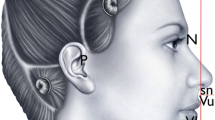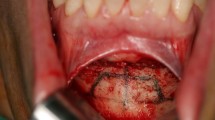Abstract
Purpose
Genioplasty facilitates alteration of the chin position and contour which contributes to aesthetics and function. The response of the hard and soft tissues following genioplasty has not been assessed after a year or more of the surgery being performed. Hence, the aim of this systematic review was to assess the response of the hard and soft tissues occurring at least 1 year after the procedure.
Material and methods
A literature search was conducted in the following electronic databases: PubMed, Ovid, LILACS, and Cochrane Library. Potential articles were identified wherein only studies with genioplasty performed as an isolated procedure and with data at least 12 months after the procedure were included.
Results
Five studies were included in this systematic review. Two of the articles included were considered to be of good quality while three were considered to be of moderate quality using a modified Downs and Black tool. The ROBINS-I tool showed a moderate risk of bias for most domains. The study characteristics revealed varying degrees of relapse for the hard and soft tissues.
Conclusions
In the anteroposterior plane, the soft tissue relapsed more than the hard tissues 3 years post genioplasty. However, relapse in the vertical plane showed a wide variation for both the hard and soft tissues. In the anteroposterior plane, the hard tissue to soft tissue response 2 years or more following genioplasty ranged from 1:0.77 to 1:0.91 while in the vertical plane the hard tissue to soft tissue response ranged from 1:0.67 to 1:1.16.



Similar content being viewed by others
References
Morera Serna E, Scola Pliego E, Mir Ulldemolins N, Martínez MA (2008) Tratamiento de las deformidades del mentón [Treatment of chin deformities]. Acta Otorrinolaringol Esp 59(7):349–358
Skinazi GLS, Lindauer SJ, Isaacson RJ (1994) Chin, nose, and lips. Normal ratios, in young men and women. Am J Orthod Dentofac Orthop 106(5):518–523
Naini FB, Donaldson ANA, McDonald F, Cobourne MT (2012) Assessing the influence of chin prominence on perceived attractiveness in the orthognathic patient, clinician and layperson. Int J Oral Maxillofac Surg 41(7):839–846
Olkun HK, Borzabadi-Farahani A, Uçkan S (2019) Orthognathic surgery treatment need in a Turkish adult population: a retrospective study. Int J Environ Res Public Health 16(11):1881
Shaughnessy S, Mobarak K, Hogevold HE, Espeland L (2006) Long-term skeletal and soft-tissue responses after advancement genioplasty. Am J Orthod Dentofac Orthop 130:8–17
Ho CT, Huang CS, Lo LJ (2012) Improvement of chin profile after mandibular setback and reduction genioplasty for correction of prognathism and long chin. Aesthetic Plast Surg 36(5):1198–1206
Khalifa GA, Mohamed FI (2018) Aesthetic outcomes and morphological changes in chin parameters after mandibular distraction and subsequent advancement genioplasty in patients with mandibular micrognathia. Int J Oral Maxillofac Surg 47(12):1572–1580
San Miguel Moragas J, Oth O, Büttner M, Mommaerts MY (2015) A systematic review on soft-to-hard tissue ratios in orthognathic surgery part II: chin procedures. J Craniomaxillofac Surg. 43(8):1530–1540
Moher D, Liberati A, Tetzlaff J, Altman DG, The PRISMA Group (2009) Preferred Reporting Items for Systematic Reviews and Meta-Analyses: the PRISMA Statement. PLoS Med 6(7):e1000097. https://doi.org/10.1371/journal.pmed1000097
Higgins JP, Green S (2011) Cochrane Handbook for Systematic Reviews of Interventions, Version 5.1. 0. London: The Cochrane Collaboration
Downs SH, Black N (1998) The feasibility of creating a checklist for the assessment of the methodological quality both of randomised and non-randomised studies of health care interventions. J Epidemiol Community Health 52:377–384
Sterne JA, Hernán MA, Reeves BC, Savović J, Berkman ND, Viswanathan M, Henry D, Altman DG, Ansari MT, Boutron I, Carpenter JR, Chan AW, Churchill R, Deeks JJ, Hróbjartsson A, Kirkham J, Jüni P, Loke YK, Pigott TD, Ramsay CR, Regidor D, Rothstein HR, Sandhu L, Santaguida PL, Schünemann HJ, Shea B, Shrier I, Tugwell P, Turner L, Valentine JC, Waddington H, Waters E, Wells GA, Whiting PF, Higgins JP (2016) ROBINS-I: a tool for assessing risk of bias in non-randomised studies of interventions. BMJ. 355:i4919
McGuinness LA (2019) robvis: an R package and web application for visualising risk-of-bias assessments. https://github.com/mcguinlu/robvis. Accessed 23 Sept 2020
Budharapu A, Sinha R, Tauro DP, Tiwari PK (2018) Musculoskeletal changes as a sequel to advancement genioplasty: a long-term cephalometric prospective study. J Maxillofac Oral Surg 17(2):233–241. https://doi.org/10.1007/s12663-017-1025-8
Kumar BL, Raju GK, Kumar ND, Reddy GV, Naik BR, Achary CR (2015) Long term stability following genioplasty: a cephalometric study. J Int Oral Health 7(4):44–50
Erbe C, Mulié RM, Ruf S (2011) Advancement genioplasty in Class I patients: predictability and stability of facial profile changes. Int J Oral Maxillofac Surg 40(11):1258–1262
Talebzadeh N, Pogrel MA (2001) Long-term hard and soft tissue relapse rate after genioplasty. Oral Surg Oral Med Oral Pathol Oral Radiol Endod 91(2):153–156
Simons RL, Lawson W (1975) Chin reduction in profileplasty. Arch Otolaryngol 101(4):207–210
Vedtofte P, Nattestad A, Svendsen H (1991) Soft tissue changes after advancement genioplasty performed as pedicled or free transplants. J Craniomaxillofac Surg 19(7):304–310
Bell WH, Dann JJ III (1973) Correction of dentofacial deformities by surgery in the anterior part of the jaws: a study of stability and soft-tissue changes. Am J Orthod 64(2):162–187
Ellis E III, Dechow PC, McNamara JA Jr, Carlson DS, Liskiewicz WE (1984) Advancement genioplasty with and without soft tissue pedicle: an experimental investigation. J Oral Maxillofac Surg 42(10):637–645
Reyneke JP, Johnston T, Vander Linden WJ (1997) Screw osteosynthesis compared with wire osteosynthesis in advancement genioplasty: retrospective study of skeletal stability. Br J Oral Maxillofac Surg 35:352–356
Author information
Authors and Affiliations
Corresponding author
Ethics declarations
Ethics approval
Not applicable.
Patient consent
Not applicable.
Competing interests
The authors declare no competing interest.
Additional information
Publisher's note
Springer Nature remains neutral with regard to jurisdictional claims in published maps and institutional affiliations.
Rights and permissions
About this article
Cite this article
George, J.A., Kannan, A. & Kailasam, V. Long-term hard and soft tissue response following isolated genioplasty: a systematic review. Oral Maxillofac Surg 26, 195–203 (2022). https://doi.org/10.1007/s10006-021-00991-7
Received:
Accepted:
Published:
Issue Date:
DOI: https://doi.org/10.1007/s10006-021-00991-7




